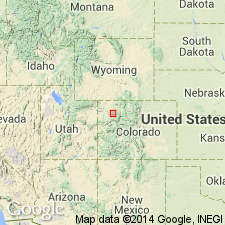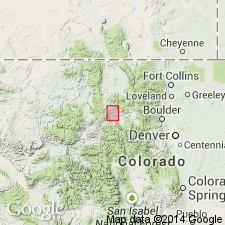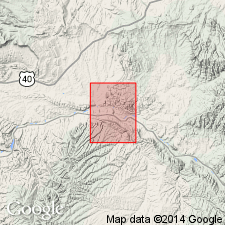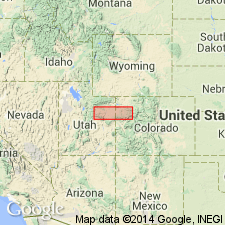
- Usage in publication:
-
- Loyd Sandstone Member*
- Modifications:
-
- Areal extent
- AAPG geologic province:
-
- Piceance basin
- Green River basin
Summary:
Used as named and defined by Konishi (1959)--a sandstone in the Mancos Shale in Moffat Co, CO in Greater Green River basin. Is a useful marker throughout most of southeastern part of Axial basin and into the Meeker area of Rio Blanco Co, CO in Piceance basin. Westward extent not known. Is of Late Cretaceous Campanian, or early Montana age. Contains a varied fauna (pelecypods, gastropods, and cephalopods).
Source: GNU records (USGS DDS-6; Denver GNULEX).

- Usage in publication:
-
- Loyd Sandstone Member*
- Modifications:
-
- Overview
- AAPG geologic province:
-
- Green River basin
Summary:
Correlation of the Upper Cretaceous Pierre Shale (and its Hygiene, Terry, Rocky Ridge, and Larimer Sandstone Members) near Boulder, CO with the Pierre Shale (and its Sharon Springs, Kremmling, Muddy Buttes, Hygiene, Carter and Gunsight Pass Members) near Kremmling, CO, and with the upper part of the Mancos Shale (and its Morapos and Loyd Sandstone Members) and with the Iles Formation (and its Tow Creek and Trout Creek Sandstone Members) and Williams Fork Formation (and its Twentymile Sandstone Member); the last two are formations of the Mesaverde Group of the Hamilton area, Moffat Co in the Greater Green River basin, shown on figure 2.
Source: GNU records (USGS DDS-6; Denver GNULEX).

- Usage in publication:
-
- Loyd Sandstone Bed*
- Modifications:
-
- Revised
- Areal extent
- AAPG geologic province:
-
- Green River basin
- Piceance basin
Summary:
Reduced to rank of bed within Buck Tongue of Mancos Shale. Locally present westward but separately mapped only along west flank of Pinyon Ridge in north-central part of quad. Farther east, Loyd considered member of Mancos where Buck Tongue has merged with main body of Mancos. Area of report is Rough Gulch quad, Rio Blanco and Moffat Cos, CO, Greater Green River basin and Piceance basin. Maximum thickness about 70 ft. Geologic map. Late Cretaceous age.
Source: GNU records (USGS DDS-6; Denver GNULEX).

- Usage in publication:
-
- Loyd Sandstone Bed*
- Modifications:
-
- Revised
- AAPG geologic province:
-
- Piceance basin
Summary:
As a part of Buck Tongue is assigned to main body of Mancos Group. Shown in subsurface from area of Douglas Creek arch to area west of White River uplift, Rio Blanco Co, CO, Piceance basin. [Buck previously assigned to Mancos Shale. In eastern Uinta and western Piceance, Molenaar and Wilson (1990, USGS Bull. 1787-M) raised rank of Mancos dividing it into, in ascending order, Mowry Shale, Frontier Formation and main body in upper part].
Source: GNU records (USGS DDS-6; Denver GNULEX).
For more information, please contact Nancy Stamm, Geologic Names Committee Secretary.
Asterisk (*) indicates published by U.S. Geological Survey authors.
"No current usage" (†) implies that a name has been abandoned or has fallen into disuse. Former usage and, if known, replacement name given in parentheses ( ).
Slash (/) indicates name conflicts with nomenclatural guidelines (CSN, 1933; ACSN, 1961, 1970; NACSN, 1983, 2005, 2021). May be explained within brackets ([ ]).

